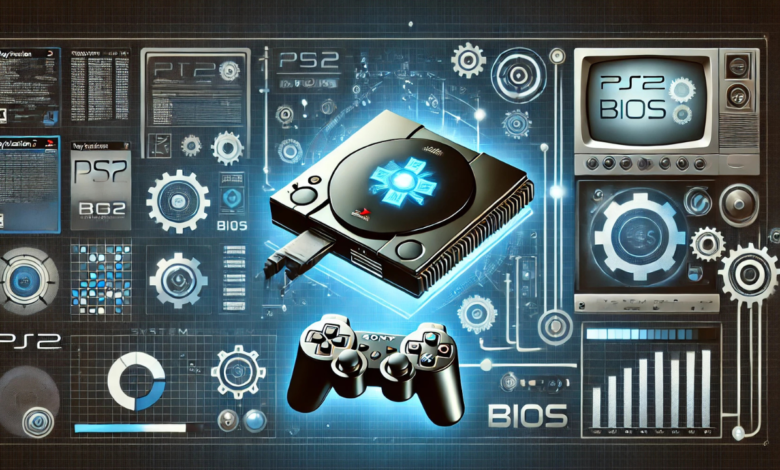PS2 BIOS Explained: What It Is and Why It Matters for Your Console

The PlayStation 2 (PS2) remains one of the most beloved and iconic gaming consoles ever. Even years after its release, players cherish their PS2 games and hardware. However, behind the scenes, the PS2’s ability to function seamlessly is powered by an essential component—the PS2 BIOS. Understanding what PS2 BIOS is, how it works, and why it matters can be crucial for gamers who want to optimize their gaming experience fully.
This article will explain the PS2 BIOS, how it works, and why it is essential for your console’s operation. We’ll also cover its role in PS2 emulation, common issues related to the BIOS, and the steps to set it up for the best performance.
What is PS2 BIOS?
The BIOS (Basic Input/Output System) is a critical system component that helps initialize and manage hardware resources for a console or computer. For the PlayStation 2, the BIOS is the system firmware that loads every time the console is powered on. It bridges the hardware and the operating system, allowing the PS2 to boot games and run applications.
The PS2 BIOS contains several essential functions that enable the console to run smoothly. It manages the system’s hardware settings, provides an interface for reading game data, and facilitates communication between the console’s processor, memory, and storage components. It also handles security features, such as preventing the console from running unauthorized or pirated software.
How Does PS2 BIOS Work?
When you turn on your PS2 console, the BIOS performs tasks to ensure the hardware is ready for operation. Here’s how it works step-by-step:
- Initialization of Hardware: The BIOS begins by performing a self-test, ensuring that the core components, such as the CPU, memory, and other peripherals, are working correctly.
- Loading System Configuration: Once the hardware is initialized, the BIOS loads configuration settings that control the console’s behavior. This includes settings related to video output, controller configuration, and system clock.
- Loading the Operating System: After initializing the hardware and loading the system settings, the BIOS loads the PS2’s operating system, which enables the console to access and interact with game data.
- Booting Games: Once the operating system runs, the BIOS plays a pivotal role in-game loading. It reads the game data from the disc, loads it into memory, and prepares it for execution on the CPU.
- Security Check: The BIOS also checks for security issues, such as verifying that the game is legitimate and that the console is not running unauthorized code. This helps protect against piracy and system modifications.
Why PS2 BIOS Matters for Your Console
PS2 BIOS is crucial in ensuring that your PlayStation 2 console functions correctly. Here’s why it matters:
- System Stability and Performance: The BIOS helps optimize hardware resources to ensure smooth gameplay. Without it, the system could fail to load games, and performance would be significantly impacted.
- Compatibility with PS2 Games: Each PS2 game was designed with a specific BIOS configuration in mind. The BIOS ensures the console can load and play these games without issues.
- Security and Anti-Piracy: The PS2 BIOS includes a series of security protocols that prevent the console from running pirated or modified software. This anti-piracy feature helps to protect the console and its games from illegal use.
- Enabling Emulation: The BIOS is essential for gamers who want to emulate PS2 games on devices like PCs. Without the PS2 BIOS, emulators would not function properly, and you couldn’t play PS2 games on your computer.
- Game Region Control: The BIOS also controls game region restrictions, preventing the console from running games not intended for your region. This adds an extra layer of control over game compatibility.
PS2 BIOS and Emulation
One of the most significant uses of PS2 BIOS today is in emulation. Emulation allows players to run PS2 games on other devices like computers, tablets, or smartphones. This is especially popular for those who no longer own a PS2 console or want to experience higher-resolution games.
However, to run PS2 games on an emulator, you need the PS2 BIOS file. The BIOS file is required to mimic the behavior of the PlayStation 2 hardware, ensuring that games run correctly. This is a crucial emulation aspect because it allows the emulator to simulate the PS2’s hardware environment and provide an authentic gaming experience.
It’s important to note that while the PS2 BIOS can be extracted from your console for personal use, downloading or distributing BIOS files from unofficial sources is illegal and can lead to copyright violations.
Common Issues with PS2 BIOS
Like any piece of software, the PS2 BIOS can sometimes experience issues. Here are some common problems and solutions:
- PS2 BIOS File Not Detected: Sometimes, when trying to run a PS2 emulator, the BIOS file might not be detected. This can happen if the file is corrupted or misplaced. Ensure that the BIOS file is in the correct folder and adequately named.
- Game Boot Errors: If you encounter errors while trying to boot games, it might be due to a mismatch between the BIOS version and the game region. Ensure that the BIOS you’re using matches the region of the game you’re trying to play.
- Performance Issues: If your games are running poorly or are lagging, it could be due to an outdated BIOS or incorrect system settings. Try updating the BIOS or adjusting the emulator settings to improve performance.
- Region Locking: The PS2 BIOS may prevent you from running games from different regions. If you’re using a region-locked BIOS, consider using a modified BIOS to bypass the restrictions, but remember that doing so might void your warranty.
How to Set Up PS2 BIOS for Optimal Performance
To ensure that your PS2 BIOS is set up for optimal performance, follow these steps:
- Extract the BIOS: If you’re using a physical PS2, you can extract the BIOS from your console using specific tools. Ensure you have a legal copy of the BIOS before proceeding.
- Install an Emulator: Download a PS2 emulator like PCSX2, one of the most popular and reliable emulators available.
- Place the BIOS File in the Correct Directory: When installing the emulator, you’ll be prompted to place the PS2 BIOS in a specific folder. Ensure the file is placed correctly to avoid detection issues.
- Configure the Emulator Settings: Adjust the emulator’s settings to match your system’s specifications. This includes video settings, controller configuration, and other system preferences.
- Run Your Game: Once everything is set up, you should be ready to run your PS2 games smoothly. If you encounter any issues, refer to the emulator’s help files or adjust the BIOS settings.
Conclusion
The PS2 BIOS is an essential component of the PlayStation 2 console, playing a crucial role in system initialization, game loading, and security. It is also vital for emulation, enabling gamers to enjoy their favorite PS2 titles on modern devices. By understanding how PS2 BIOS works and why it matters, you can ensure a smooth and enjoyable gaming experience on your PlayStation 2 console or through an emulator.
If you’re a fan of retro gaming or looking to emulate PS2 titles, knowing how to set up and maintain the PS2 BIOS properly is key to unlocking the full potential of your gaming experience.
FAQs
1. What is the role of PS2 BIOS in gaming?
PS2 BIOS is responsible for initializing the hardware, loading system settings, and ensuring smooth gameplay. It also helps with game compatibility and prevents unauthorized software from running on the console.
2. How can I extract PS2 BIOS for use in emulators?
Using specific tools, you can extract the PS2 BIOS from your physical PS2 console. However, it is essential to ensure you have a legal copy for personal use.
3. Can I use PS2 BIOS for emulation on my PC?
The PS2 BIOS is required for emulators like PCSX2 to run PS2 games on your PC. It helps the emulator mimic the PlayStation 2’s hardware environment.
4. What issues can I encounter with PS2 BIOS?
Common issues include the undetected BIOS file, game boot errors, performance issues, and region locking. Ensure the BIOS file is correctly placed and up-to-date to avoid these problems.
5. How do I fix PS2 BIOS boot errors?
Ensure that the BIOS version matches the region of your game. Additionally, check that the BIOS file is not corrupted and located in the emulator’s correct directory.



